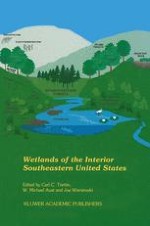1995 | OriginalPaper | Chapter
Reservoir Riparian Zone Characteristics in the Upper Tennessee River Valley
Author : C. C. Amundsen
Published in: Wetlands of the Interior Southeastern United States
Publisher: Springer Netherlands
Included in: Professional Book Archive
Activate our intelligent search to find suitable subject content or patents.
Select sections of text to find matching patents with Artificial Intelligence. powered by
Select sections of text to find additional relevant content using AI-assisted search. powered by
Impoundments in the upper Tennessee River Basin have inundated historic river riparian and mesic valley slope habitats. Fifteen major Tennessee Valley Authority (TVA) reservoirs, upstream of Chattanooga TN, have effected 50,000 ha of modern reservoir riparian zones on formerly mesic terrain. These zones were defined here as winter mudflats between winter pool shores and summer pool shores and summer riparian habitats with diminishing soil saturation from summer shores up to flood zone boundaries. Watts Bar (WB), the largest of these 15 projects in terms of area, was chosen for background and field analyses of the consequential reservoir riparian processes and expressions. WB, at the median age of areal TVA reservoirs, was closed in 1942. Transects were taken in the WB summer riparian forest after consideration of topoedaphics, species composition, and the level of contemporary disturbance. Regional bottomland forests were compared. Coefficients of species similarity showed 70% compositional similarity. The basal area (BA) density of WB summer riparian forests was not similar as was composition in regional bottomland stands. Four (of twelve) subjectively selected WB transect BA densities were compared nonparametrically and were the same (90% confidence) as other bottomland stands of like chronology. Overall however, WB stands averaged 19.6 m2/ha BA to 30.0 + for regional comparisons. Stocking was low, but measured litterfall was relatively high, resulting in similar biomass productivity corrected on a unit area basis. The winter mudflats showed expanding development of phenologically distinct herbaceous and graminoid communities under a five to six month drawdown exposure regime. Thermal modifications from the winter pool heat sink were determined to alter the mudflat microenvironment. A recent shortening of the drawdown period has interrupted the adapted life history strategy of the counter-seasonal plants, and seed maturity has been restricted. Erosion of the summer shore has been increasing the extent of the mudflats at the expense of the hydrologically influenced summer riparian habitat foreslope. The discernable trend of summer riparian stand succession over mesic expression will be limited by the height and hydric avoidance occasioned by an abrupt slope to mesic, unsaturated profile, conditions. Approximations of biomass production potential pre-and post impoundment have shown a 12:1 diminution from historic carbon detention, on a seasonal basis, within normal pool shore boundaries. Further approximations comparing the WB summer riparian forest carbon retention and detention to historic forest compartments highlighted the importance of a relatively copious, non-lignified, litterfall in the seasonally available carbon budget.
